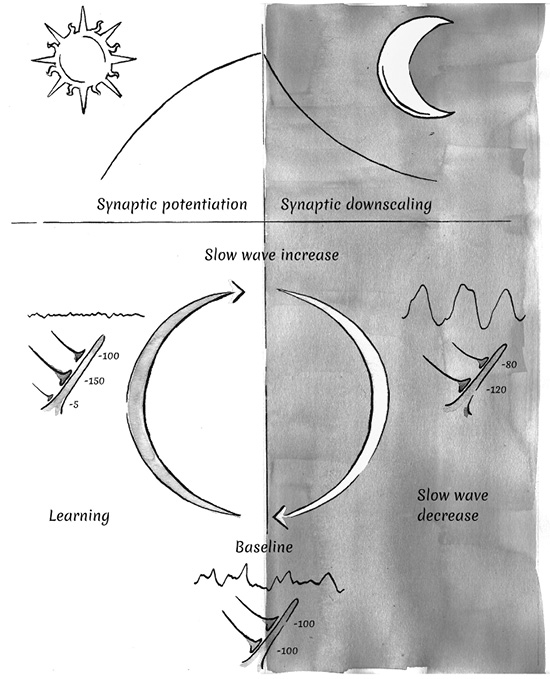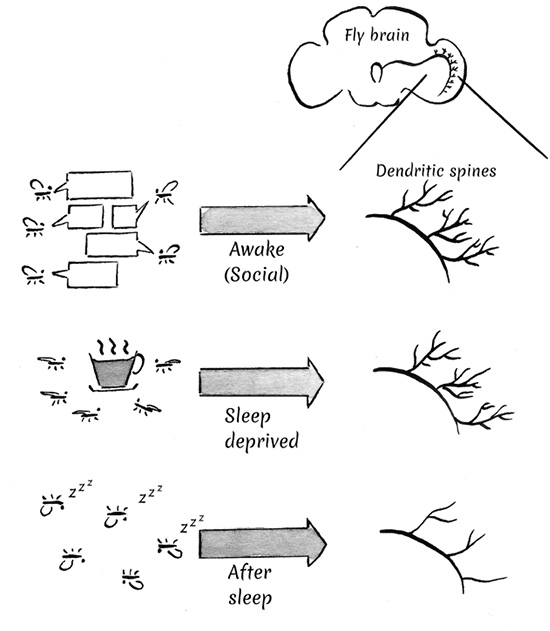mental spring cleaning while you sleep
If you have a garage, attic, or even a large space under your bed, you will know how easy it is for this to turn into an accumulation zone for random objects. You will also know that having lots of things stuffed away in there isn’t always a good idea. Sure, you may have saved every yogurt container and rubber band that ever came your way, but excessive clutter almost always means it will be harder to find the things you really want when you want them. This general principle of storage space is equally true for the brain: It is better to store just the most important things and throw out the unwanted garbage. The usual way of making this happen is by having a regular clean-up time when the critical stuff gets separated from the trash.
There is strong evidence that sleep, and specifically slow wave sleep, provides a sort of spring cleaning for the brain. It turns out there is a limit to how much synaptic connections between neurons can be strengthened. Think back to the parallel between how synaptic inputs control the response of a neuron and how advice from friends controls your decision making. If you wind up with five friends, each of whom has so much influence over you that you instantly follow their advice without attention to anyone else, your decision making may become noisy and suboptimal. In the same way, if you strengthen too many input synapses onto any given cell, further strengthening becomes almost meaningless, as the cell is already hyperstimulated. During a day of normal experience we encounter lots of information, most of which is useless and need not be remembered. Unfortunately, our brains don’t always filter this information efficiently, and this means lots of synapses get strengthened, some relating to important information we want to remember, some relating to unimportant information, and some relating to the pure meaningless noise. This means that by the end of the day our synapses are a mess. Just as we sometimes feel exhausted after a lengthy period of stimulating activity with no chance to rest, the resource available at a synapse can also be exhausted. Synapses can be overpotentiated, meaning they’ve been strengthened to the point where they can get no stronger. They can also be saturated, meaning they are potentially unable to take in new information. They cannot function optimally in this state. Something has to happen in order to clean up the mess, reset the synapses, and get rid of the unwanted information that has been stored. That something is sleep.
An elegant theory, called the synaptic homeostasis model (Fig. 11), proposes that slow wave sleep resets the whole system by globally downscaling synapses (in other words, by gradually weakening or de-potentiating them).1 This downscaling not only makes space for new learning, it also removes noise and (assuming the important information has been encoded more strongly than unimportant information) increases the ratio between that important information and noise. This can be compared to turning down the volume on a radio so that the background static can’t be heard—even though the overall output is quieter it is still easier to understand what is being said once the noise has been removed.

Fig. 11 The synaptic homeostasis hypothesis

Fig. 12 Synaptic homeostatis in the fly brain
The strongest support for synaptic homeostasis comes from studies conducted in the fruit fly Drosophila melanogaster by Ciara Cirelli, Giulio Tononi, and colleagues at the University of Wisconsin.2 These researchers made a really clever choice by working with fruit flies since this allowed them to examine the physiological state of synapses after different wake and sleep experiences in a way that wouldn’t be possible in the human brain. This rather invasive scrutiny showed that synapses grew in size and number during wake and decreased only when the flies were allowed to sleep. Fascinatingly, the extent of synaptic growth was determined by what each fly experienced during the day—so flies placed in a highly social environment (a fly mall, with lots of other flies) showed substantially more synaptic growth than flies kept in solitary confinement. Thoroughly socialized flies then needed more sleep than solitary flies, and this sleep resulted in synaptic downscaling. The synapses of flies that were sleep deprived weren’t downscaled, supporting the idea that sleep is essential for this process.
Support for the synaptic homeostasis model isn’t limited to flies. Cirelli, Tononi, and colleagues have conducted a series of experiments in humans, all of which point in the same direction. For a start, when humans spend hours and hours training on a hand-eye coordination task that is known to involve one specific area of the motor cortex, they subsequently get more sleep slow waves in exactly this cortical area—suggesting that these high-amplitude oscillations are needed for the targeted downscaling of those overpotentiated synapses.3 Conversely, if people are asked to wear an arm sling that prevents them from using one arm and hand, they subsequently show less slow waves in the cortical areas associated with these particular limbs.4 Finally, the same research group tried to artificially potentiate synapses in a specific bit of the neocortex using a stimulation technique called transcranial magnetic stimulation (in which an electromagnet pulses magnetism at targeted brain areas—through the scalp/skull, etc.—inducing random cell firing in the target region).5 This led not only to the desired potentiation of synapses in this region but also to an increase in the number of slow waves which occurred there early in the night—once again supporting the idea that localized potentiation leads to localized slow waves, until the potentiation has been reduced to normal levels.
The targeted slow waves in these experiments typically predict the extent to which performance improves across the night of sleep. This is critical to the idea that downscaling could facilitate memory consolidation because it clearly shows the memories in question are not simply wiped out by this process. Instead they are somehow refined or strengthened—which brings us back to the concept of tuning a radio and sharpening a signal.
Although we normally think of sleep as a whole-brain phenomenon, the fact that slow wave activity can increase locally in those areas of the brain where synapses are most strongly potentiated seems to suggest this is a simplification. Indeed, it turns out that small areas of the brain can exhibit properties of slow wave sleep even when you’re wide awake. During wakefulness, neurons fire irregularly, which is why the EEG—electroencephalography—which measures how brain responses vary over time shows fast irregular oscillations (see chapter 1). When you enter slow wave sleep, this pattern is quite different. Instead of irregular (but fairly constant) firing, neurons have “off” periods when they don’t fire and “on” periods when they do, and this combination creates slow waves. Very recent neural recordings in rats have shown that localized areas of the neocortex can exhibit this off/on pattern when a rat is tired (e.g., after it has been awake for a long time), even if the rat is wide awake and active. It looks like small areas of the cortex are slyly napping on the job, without waiting for the whole brain to fall asleep. This impression is emphasized by the fact that the rats do worse at various tasks (in this case reaching out to collect little sugar pills) when parts of the brain are napping in this way.6
Summing Up
This chapter should have convinced you that, like every good cellar or attic, the brain needs a regular clear-out. The evidence from both flies and humans strongly suggests that this type of synaptic downscaling (or synaptic homeostasis) is part of the function of slow wave sleep. The idea that such cleaning sharpens the signal-to-noise ratio of important memories so they pop out from the background of unwanted garbage provides an initial hypothesis about how sleep may act to facilitate subsequent remembering. In the next two chapters, you’ll read about how memories are replayed during sleep and how such replay could relate to dream imagery. We will revisit the idea of synaptic homeostasis and the “memory tuning” hypothesis at the end of chapter 6, where we’ll think about how it fits in (or doesn’t) with other theories of sleep and memory.